Business Law Assignment: Business Structures and Negligence Cases
VerifiedAdded on 2020/05/16
|11
|2396
|52
Report
AI Summary
This report addresses two key areas within business law: business structures and negligence. The first part of the report analyzes different business structures, including sole proprietorships, partnerships, and companies, comparing their features, advantages, and disadvantages to recommend the most suitable structure for a specific business scenario. The second part focuses on negligence, defining it and outlining the elements required to establish a claim, namely duty of care, breach of duty of care, and causation. It explains relevant legal tests such as the Caparo test and the "but for" test, and applies these principles to a case involving a dog attack, analyzing whether a negligence claim can be made. The report also touches upon contributory negligence and the concept of damages, providing a comprehensive overview of both topics. This assignment is designed to provide a clear understanding of business law principles and their practical application.
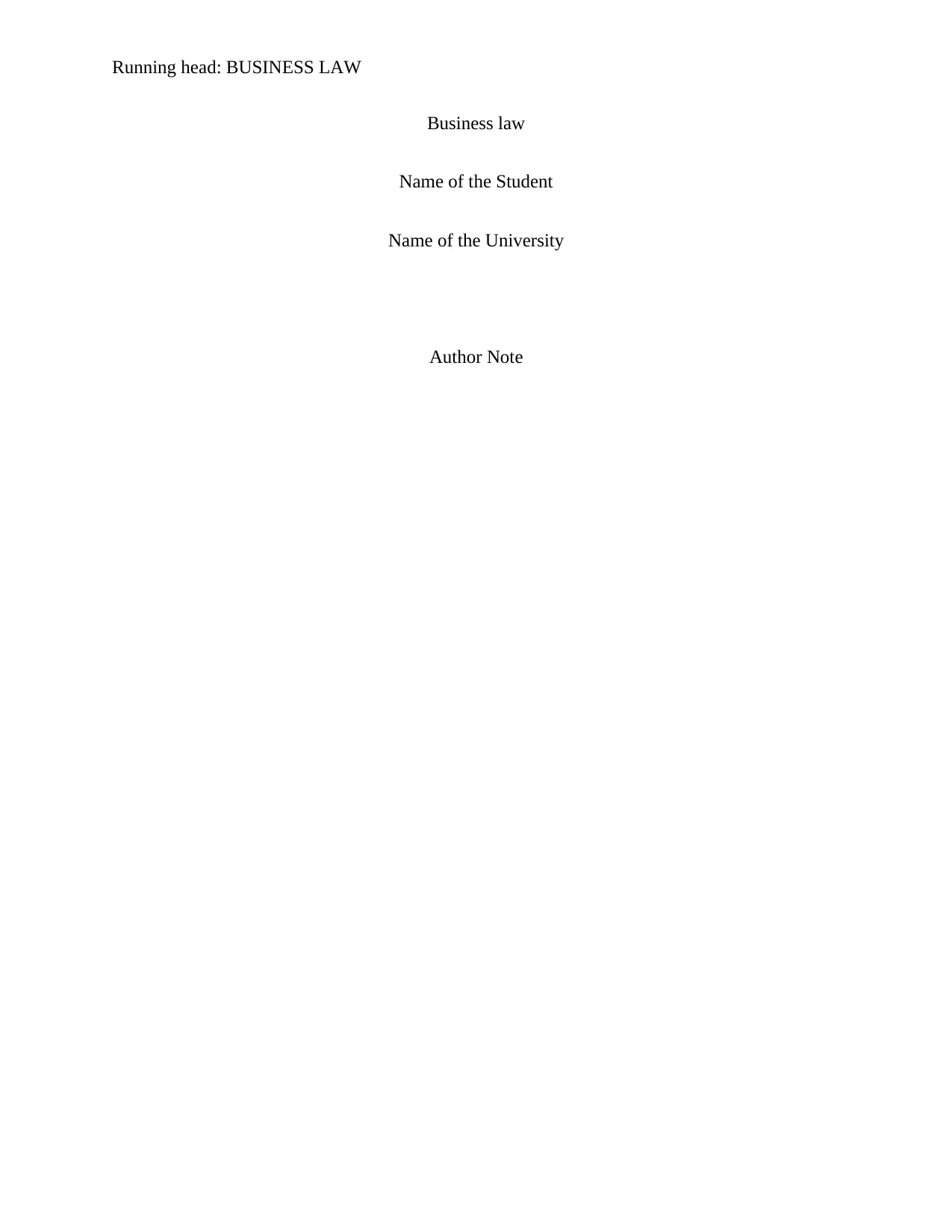
Running head: BUSINESS LAW
Business law
Name of the Student
Name of the University
Author Note
Business law
Name of the Student
Name of the University
Author Note
Paraphrase This Document
Need a fresh take? Get an instant paraphrase of this document with our AI Paraphraser
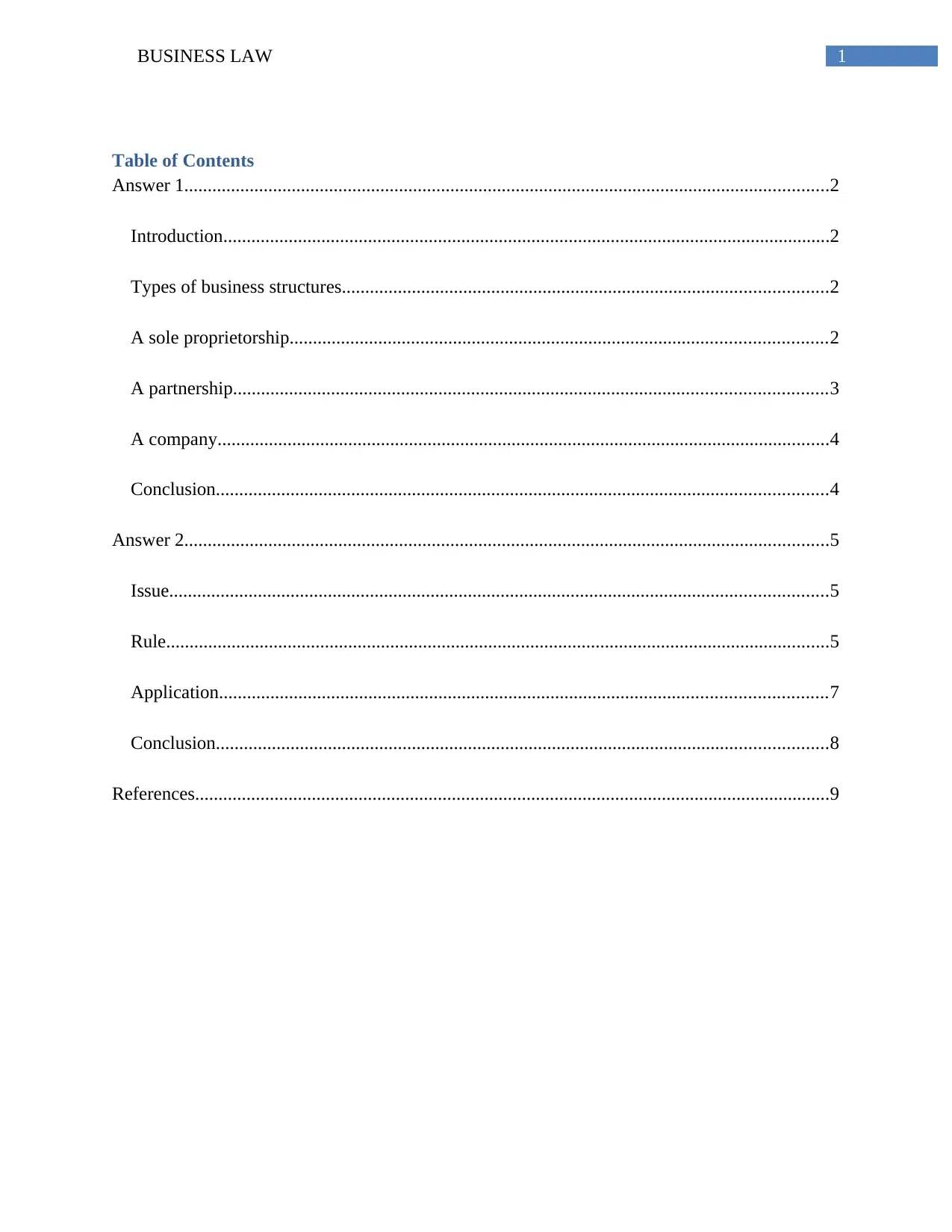
1BUSINESS LAW
Table of Contents
Answer 1..........................................................................................................................................2
Introduction..................................................................................................................................2
Types of business structures........................................................................................................2
A sole proprietorship...................................................................................................................2
A partnership...............................................................................................................................3
A company...................................................................................................................................4
Conclusion...................................................................................................................................4
Answer 2..........................................................................................................................................5
Issue.............................................................................................................................................5
Rule..............................................................................................................................................5
Application..................................................................................................................................7
Conclusion...................................................................................................................................8
References........................................................................................................................................9
Table of Contents
Answer 1..........................................................................................................................................2
Introduction..................................................................................................................................2
Types of business structures........................................................................................................2
A sole proprietorship...................................................................................................................2
A partnership...............................................................................................................................3
A company...................................................................................................................................4
Conclusion...................................................................................................................................4
Answer 2..........................................................................................................................................5
Issue.............................................................................................................................................5
Rule..............................................................................................................................................5
Application..................................................................................................................................7
Conclusion...................................................................................................................................8
References........................................................................................................................................9
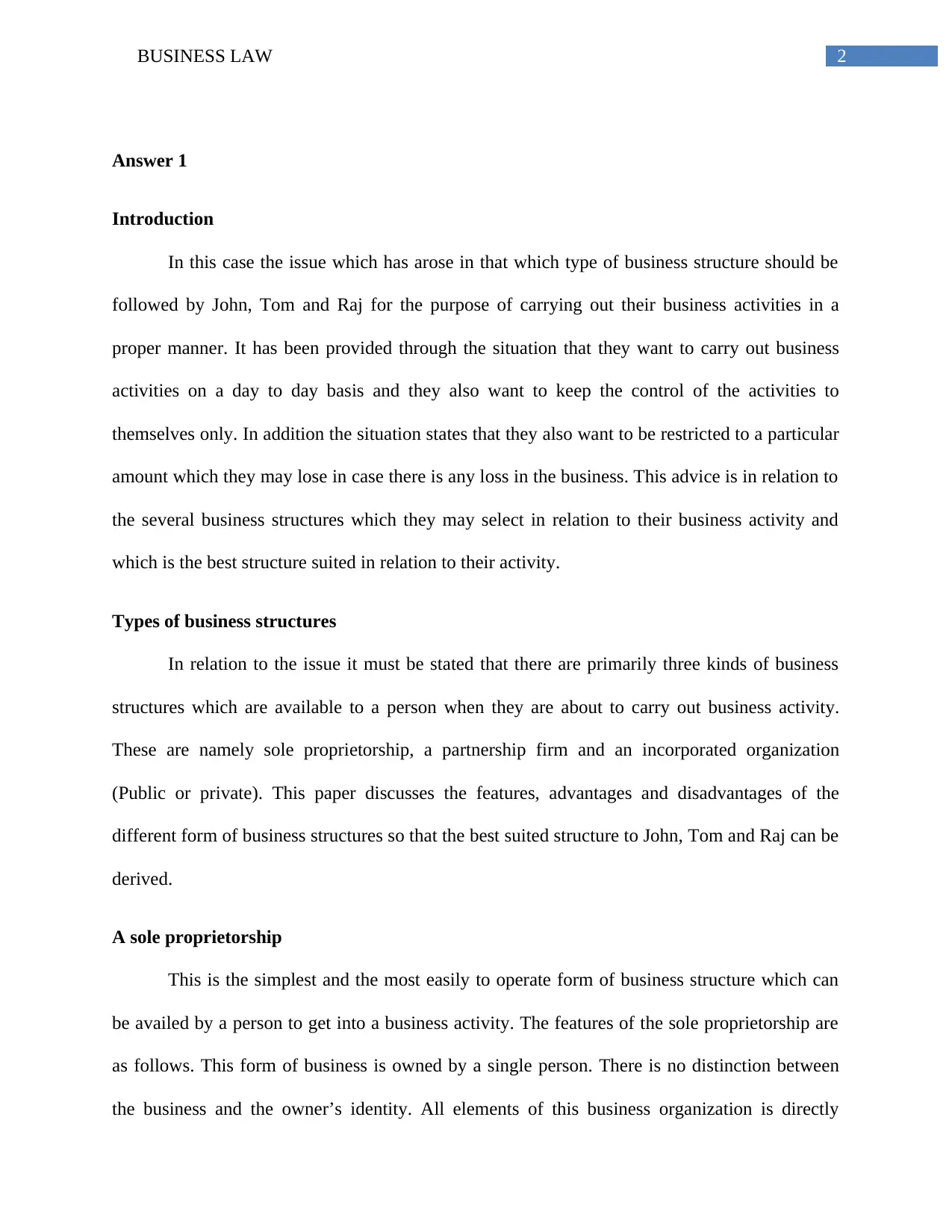
2BUSINESS LAW
Answer 1
Introduction
In this case the issue which has arose in that which type of business structure should be
followed by John, Tom and Raj for the purpose of carrying out their business activities in a
proper manner. It has been provided through the situation that they want to carry out business
activities on a day to day basis and they also want to keep the control of the activities to
themselves only. In addition the situation states that they also want to be restricted to a particular
amount which they may lose in case there is any loss in the business. This advice is in relation to
the several business structures which they may select in relation to their business activity and
which is the best structure suited in relation to their activity.
Types of business structures
In relation to the issue it must be stated that there are primarily three kinds of business
structures which are available to a person when they are about to carry out business activity.
These are namely sole proprietorship, a partnership firm and an incorporated organization
(Public or private). This paper discusses the features, advantages and disadvantages of the
different form of business structures so that the best suited structure to John, Tom and Raj can be
derived.
A sole proprietorship
This is the simplest and the most easily to operate form of business structure which can
be availed by a person to get into a business activity. The features of the sole proprietorship are
as follows. This form of business is owned by a single person. There is no distinction between
the business and the owner’s identity. All elements of this business organization is directly
Answer 1
Introduction
In this case the issue which has arose in that which type of business structure should be
followed by John, Tom and Raj for the purpose of carrying out their business activities in a
proper manner. It has been provided through the situation that they want to carry out business
activities on a day to day basis and they also want to keep the control of the activities to
themselves only. In addition the situation states that they also want to be restricted to a particular
amount which they may lose in case there is any loss in the business. This advice is in relation to
the several business structures which they may select in relation to their business activity and
which is the best structure suited in relation to their activity.
Types of business structures
In relation to the issue it must be stated that there are primarily three kinds of business
structures which are available to a person when they are about to carry out business activity.
These are namely sole proprietorship, a partnership firm and an incorporated organization
(Public or private). This paper discusses the features, advantages and disadvantages of the
different form of business structures so that the best suited structure to John, Tom and Raj can be
derived.
A sole proprietorship
This is the simplest and the most easily to operate form of business structure which can
be availed by a person to get into a business activity. The features of the sole proprietorship are
as follows. This form of business is owned by a single person. There is no distinction between
the business and the owner’s identity. All elements of this business organization is directly
⊘ This is a preview!⊘
Do you want full access?
Subscribe today to unlock all pages.

Trusted by 1+ million students worldwide
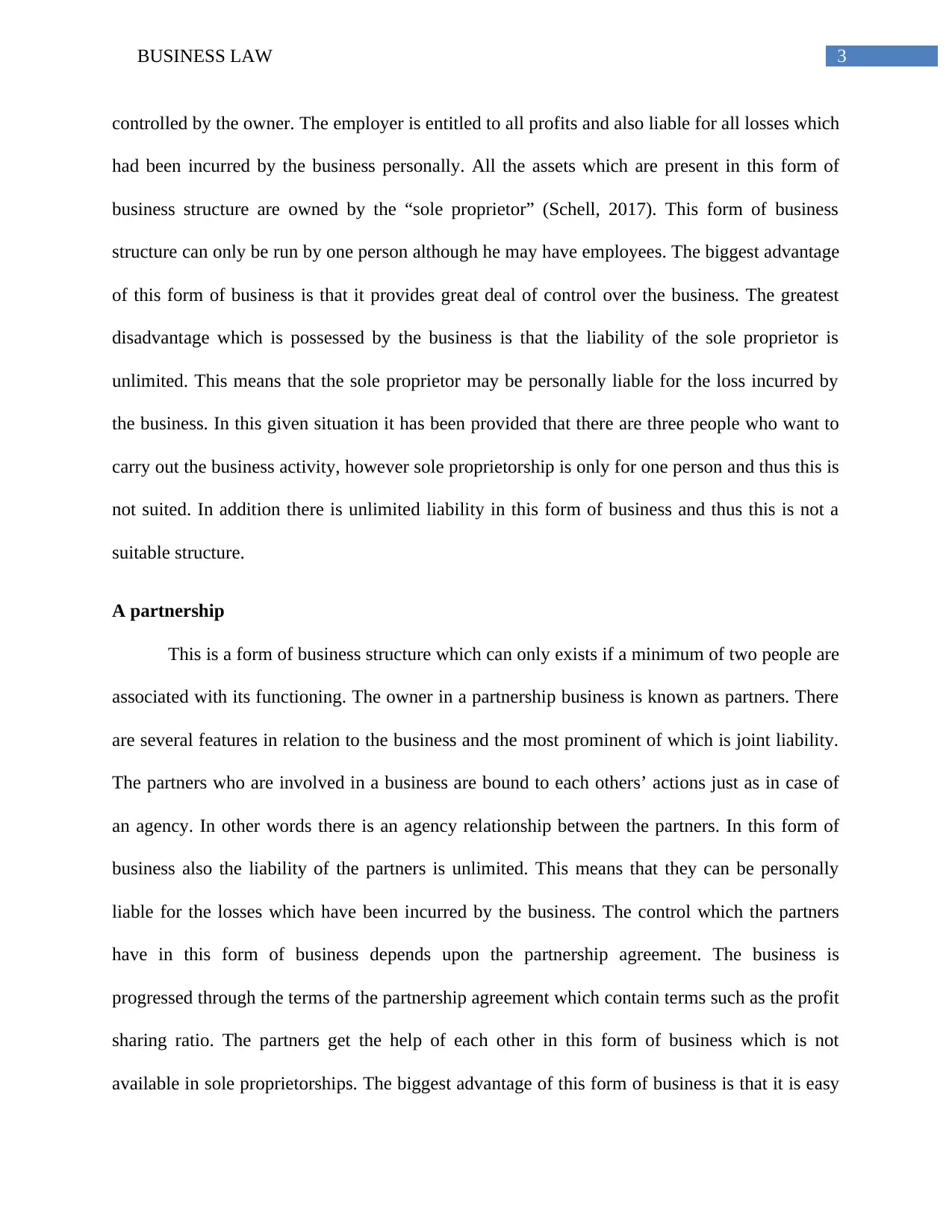
3BUSINESS LAW
controlled by the owner. The employer is entitled to all profits and also liable for all losses which
had been incurred by the business personally. All the assets which are present in this form of
business structure are owned by the “sole proprietor” (Schell, 2017). This form of business
structure can only be run by one person although he may have employees. The biggest advantage
of this form of business is that it provides great deal of control over the business. The greatest
disadvantage which is possessed by the business is that the liability of the sole proprietor is
unlimited. This means that the sole proprietor may be personally liable for the loss incurred by
the business. In this given situation it has been provided that there are three people who want to
carry out the business activity, however sole proprietorship is only for one person and thus this is
not suited. In addition there is unlimited liability in this form of business and thus this is not a
suitable structure.
A partnership
This is a form of business structure which can only exists if a minimum of two people are
associated with its functioning. The owner in a partnership business is known as partners. There
are several features in relation to the business and the most prominent of which is joint liability.
The partners who are involved in a business are bound to each others’ actions just as in case of
an agency. In other words there is an agency relationship between the partners. In this form of
business also the liability of the partners is unlimited. This means that they can be personally
liable for the losses which have been incurred by the business. The control which the partners
have in this form of business depends upon the partnership agreement. The business is
progressed through the terms of the partnership agreement which contain terms such as the profit
sharing ratio. The partners get the help of each other in this form of business which is not
available in sole proprietorships. The biggest advantage of this form of business is that it is easy
controlled by the owner. The employer is entitled to all profits and also liable for all losses which
had been incurred by the business personally. All the assets which are present in this form of
business structure are owned by the “sole proprietor” (Schell, 2017). This form of business
structure can only be run by one person although he may have employees. The biggest advantage
of this form of business is that it provides great deal of control over the business. The greatest
disadvantage which is possessed by the business is that the liability of the sole proprietor is
unlimited. This means that the sole proprietor may be personally liable for the loss incurred by
the business. In this given situation it has been provided that there are three people who want to
carry out the business activity, however sole proprietorship is only for one person and thus this is
not suited. In addition there is unlimited liability in this form of business and thus this is not a
suitable structure.
A partnership
This is a form of business structure which can only exists if a minimum of two people are
associated with its functioning. The owner in a partnership business is known as partners. There
are several features in relation to the business and the most prominent of which is joint liability.
The partners who are involved in a business are bound to each others’ actions just as in case of
an agency. In other words there is an agency relationship between the partners. In this form of
business also the liability of the partners is unlimited. This means that they can be personally
liable for the losses which have been incurred by the business. The control which the partners
have in this form of business depends upon the partnership agreement. The business is
progressed through the terms of the partnership agreement which contain terms such as the profit
sharing ratio. The partners get the help of each other in this form of business which is not
available in sole proprietorships. The biggest advantage of this form of business is that it is easy
Paraphrase This Document
Need a fresh take? Get an instant paraphrase of this document with our AI Paraphraser
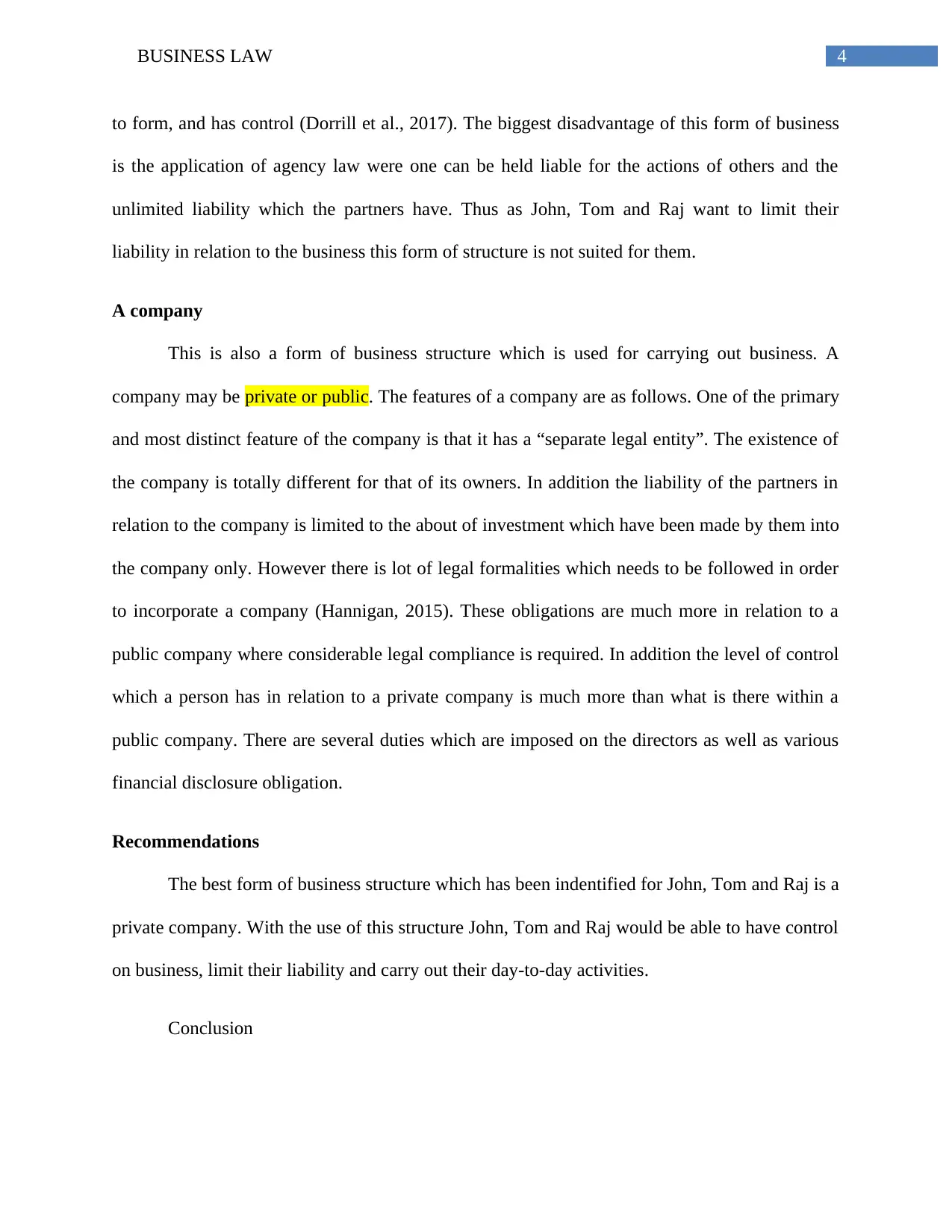
4BUSINESS LAW
to form, and has control (Dorrill et al., 2017). The biggest disadvantage of this form of business
is the application of agency law were one can be held liable for the actions of others and the
unlimited liability which the partners have. Thus as John, Tom and Raj want to limit their
liability in relation to the business this form of structure is not suited for them.
A company
This is also a form of business structure which is used for carrying out business. A
company may be private or public. The features of a company are as follows. One of the primary
and most distinct feature of the company is that it has a “separate legal entity”. The existence of
the company is totally different for that of its owners. In addition the liability of the partners in
relation to the company is limited to the about of investment which have been made by them into
the company only. However there is lot of legal formalities which needs to be followed in order
to incorporate a company (Hannigan, 2015). These obligations are much more in relation to a
public company where considerable legal compliance is required. In addition the level of control
which a person has in relation to a private company is much more than what is there within a
public company. There are several duties which are imposed on the directors as well as various
financial disclosure obligation.
Recommendations
The best form of business structure which has been indentified for John, Tom and Raj is a
private company. With the use of this structure John, Tom and Raj would be able to have control
on business, limit their liability and carry out their day-to-day activities.
Conclusion
to form, and has control (Dorrill et al., 2017). The biggest disadvantage of this form of business
is the application of agency law were one can be held liable for the actions of others and the
unlimited liability which the partners have. Thus as John, Tom and Raj want to limit their
liability in relation to the business this form of structure is not suited for them.
A company
This is also a form of business structure which is used for carrying out business. A
company may be private or public. The features of a company are as follows. One of the primary
and most distinct feature of the company is that it has a “separate legal entity”. The existence of
the company is totally different for that of its owners. In addition the liability of the partners in
relation to the company is limited to the about of investment which have been made by them into
the company only. However there is lot of legal formalities which needs to be followed in order
to incorporate a company (Hannigan, 2015). These obligations are much more in relation to a
public company where considerable legal compliance is required. In addition the level of control
which a person has in relation to a private company is much more than what is there within a
public company. There are several duties which are imposed on the directors as well as various
financial disclosure obligation.
Recommendations
The best form of business structure which has been indentified for John, Tom and Raj is a
private company. With the use of this structure John, Tom and Raj would be able to have control
on business, limit their liability and carry out their day-to-day activities.
Conclusion
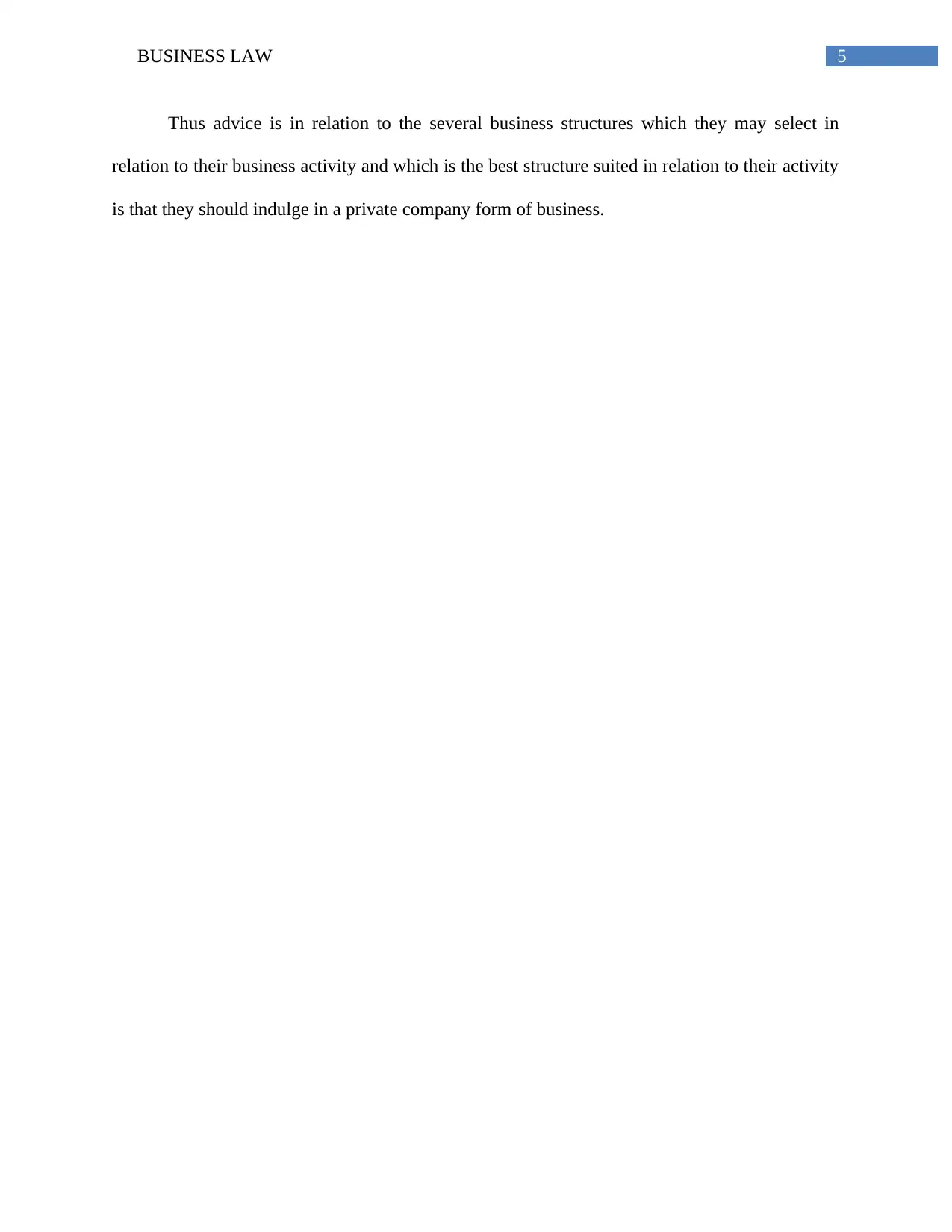
5BUSINESS LAW
Thus advice is in relation to the several business structures which they may select in
relation to their business activity and which is the best structure suited in relation to their activity
is that they should indulge in a private company form of business.
Thus advice is in relation to the several business structures which they may select in
relation to their business activity and which is the best structure suited in relation to their activity
is that they should indulge in a private company form of business.
⊘ This is a preview!⊘
Do you want full access?
Subscribe today to unlock all pages.

Trusted by 1+ million students worldwide
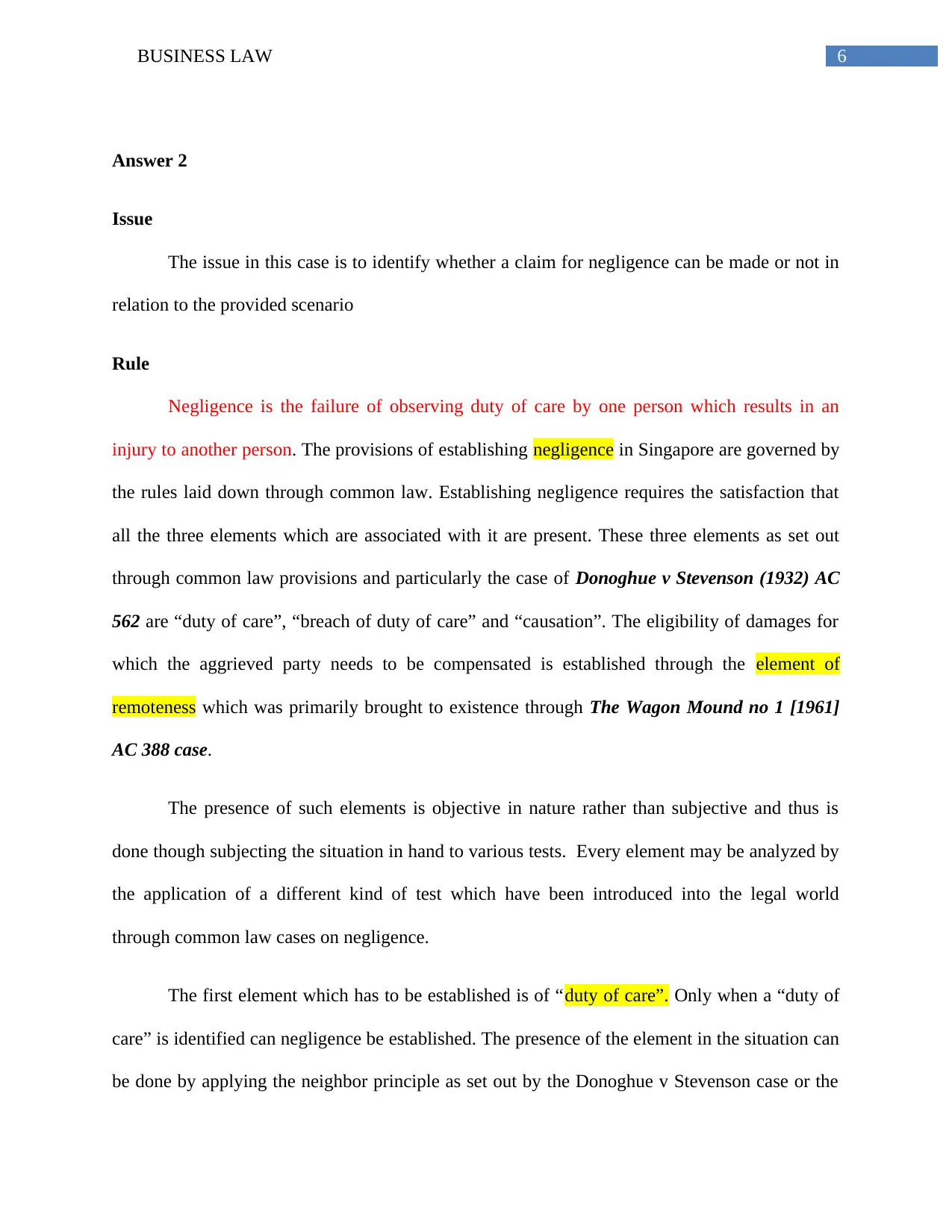
6BUSINESS LAW
Answer 2
Issue
The issue in this case is to identify whether a claim for negligence can be made or not in
relation to the provided scenario
Rule
Negligence is the failure of observing duty of care by one person which results in an
injury to another person. The provisions of establishing negligence in Singapore are governed by
the rules laid down through common law. Establishing negligence requires the satisfaction that
all the three elements which are associated with it are present. These three elements as set out
through common law provisions and particularly the case of Donoghue v Stevenson (1932) AC
562 are “duty of care”, “breach of duty of care” and “causation”. The eligibility of damages for
which the aggrieved party needs to be compensated is established through the element of
remoteness which was primarily brought to existence through The Wagon Mound no 1 [1961]
AC 388 case.
The presence of such elements is objective in nature rather than subjective and thus is
done though subjecting the situation in hand to various tests. Every element may be analyzed by
the application of a different kind of test which have been introduced into the legal world
through common law cases on negligence.
The first element which has to be established is of “duty of care”. Only when a “duty of
care” is identified can negligence be established. The presence of the element in the situation can
be done by applying the neighbor principle as set out by the Donoghue v Stevenson case or the
Answer 2
Issue
The issue in this case is to identify whether a claim for negligence can be made or not in
relation to the provided scenario
Rule
Negligence is the failure of observing duty of care by one person which results in an
injury to another person. The provisions of establishing negligence in Singapore are governed by
the rules laid down through common law. Establishing negligence requires the satisfaction that
all the three elements which are associated with it are present. These three elements as set out
through common law provisions and particularly the case of Donoghue v Stevenson (1932) AC
562 are “duty of care”, “breach of duty of care” and “causation”. The eligibility of damages for
which the aggrieved party needs to be compensated is established through the element of
remoteness which was primarily brought to existence through The Wagon Mound no 1 [1961]
AC 388 case.
The presence of such elements is objective in nature rather than subjective and thus is
done though subjecting the situation in hand to various tests. Every element may be analyzed by
the application of a different kind of test which have been introduced into the legal world
through common law cases on negligence.
The first element which has to be established is of “duty of care”. Only when a “duty of
care” is identified can negligence be established. The presence of the element in the situation can
be done by applying the neighbor principle as set out by the Donoghue v Stevenson case or the
Paraphrase This Document
Need a fresh take? Get an instant paraphrase of this document with our AI Paraphraser
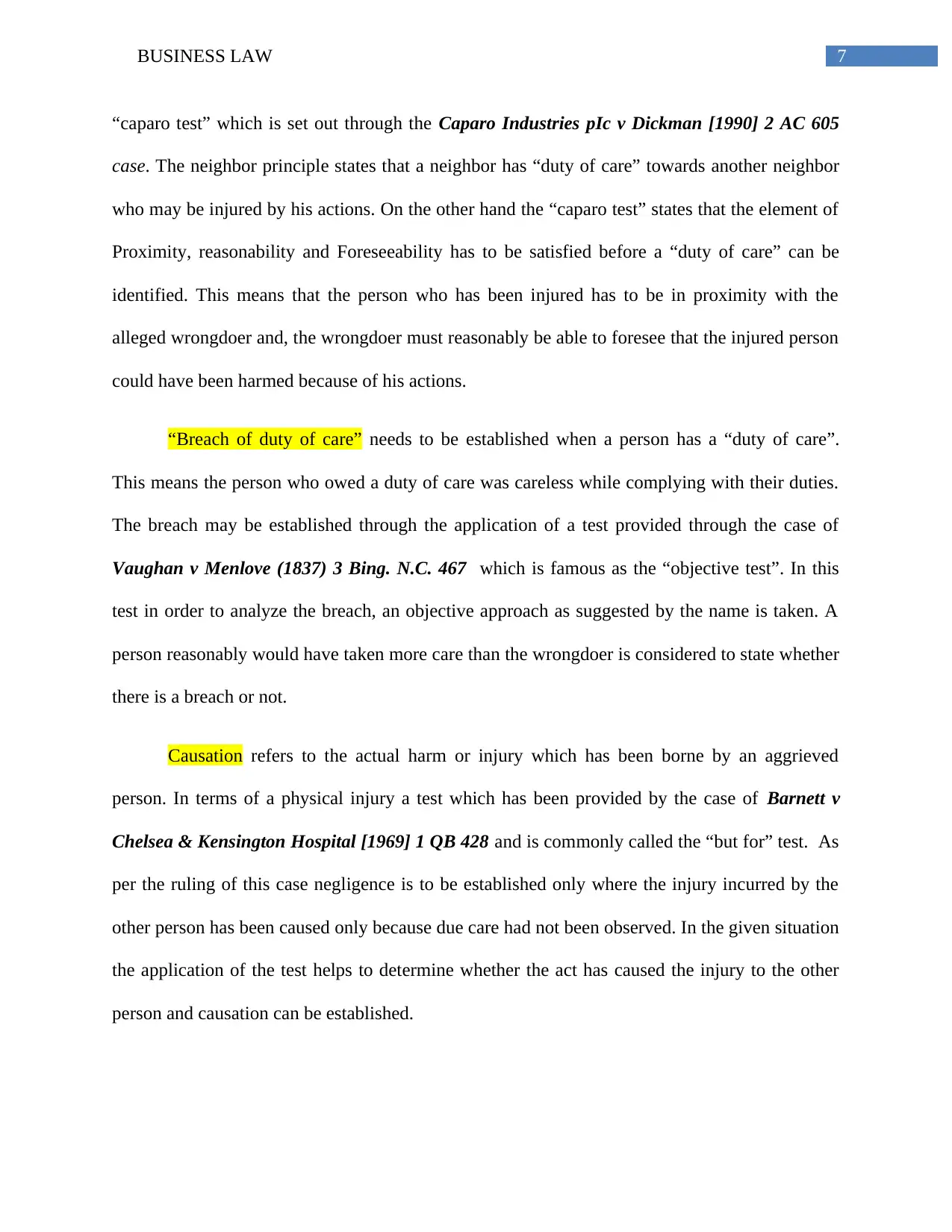
7BUSINESS LAW
“caparo test” which is set out through the Caparo Industries pIc v Dickman [1990] 2 AC 605
case. The neighbor principle states that a neighbor has “duty of care” towards another neighbor
who may be injured by his actions. On the other hand the “caparo test” states that the element of
Proximity, reasonability and Foreseeability has to be satisfied before a “duty of care” can be
identified. This means that the person who has been injured has to be in proximity with the
alleged wrongdoer and, the wrongdoer must reasonably be able to foresee that the injured person
could have been harmed because of his actions.
“Breach of duty of care” needs to be established when a person has a “duty of care”.
This means the person who owed a duty of care was careless while complying with their duties.
The breach may be established through the application of a test provided through the case of
Vaughan v Menlove (1837) 3 Bing. N.C. 467 which is famous as the “objective test”. In this
test in order to analyze the breach, an objective approach as suggested by the name is taken. A
person reasonably would have taken more care than the wrongdoer is considered to state whether
there is a breach or not.
Causation refers to the actual harm or injury which has been borne by an aggrieved
person. In terms of a physical injury a test which has been provided by the case of Barnett v
Chelsea & Kensington Hospital [1969] 1 QB 428 and is commonly called the “but for” test. As
per the ruling of this case negligence is to be established only where the injury incurred by the
other person has been caused only because due care had not been observed. In the given situation
the application of the test helps to determine whether the act has caused the injury to the other
person and causation can be established.
“caparo test” which is set out through the Caparo Industries pIc v Dickman [1990] 2 AC 605
case. The neighbor principle states that a neighbor has “duty of care” towards another neighbor
who may be injured by his actions. On the other hand the “caparo test” states that the element of
Proximity, reasonability and Foreseeability has to be satisfied before a “duty of care” can be
identified. This means that the person who has been injured has to be in proximity with the
alleged wrongdoer and, the wrongdoer must reasonably be able to foresee that the injured person
could have been harmed because of his actions.
“Breach of duty of care” needs to be established when a person has a “duty of care”.
This means the person who owed a duty of care was careless while complying with their duties.
The breach may be established through the application of a test provided through the case of
Vaughan v Menlove (1837) 3 Bing. N.C. 467 which is famous as the “objective test”. In this
test in order to analyze the breach, an objective approach as suggested by the name is taken. A
person reasonably would have taken more care than the wrongdoer is considered to state whether
there is a breach or not.
Causation refers to the actual harm or injury which has been borne by an aggrieved
person. In terms of a physical injury a test which has been provided by the case of Barnett v
Chelsea & Kensington Hospital [1969] 1 QB 428 and is commonly called the “but for” test. As
per the ruling of this case negligence is to be established only where the injury incurred by the
other person has been caused only because due care had not been observed. In the given situation
the application of the test helps to determine whether the act has caused the injury to the other
person and causation can be established.
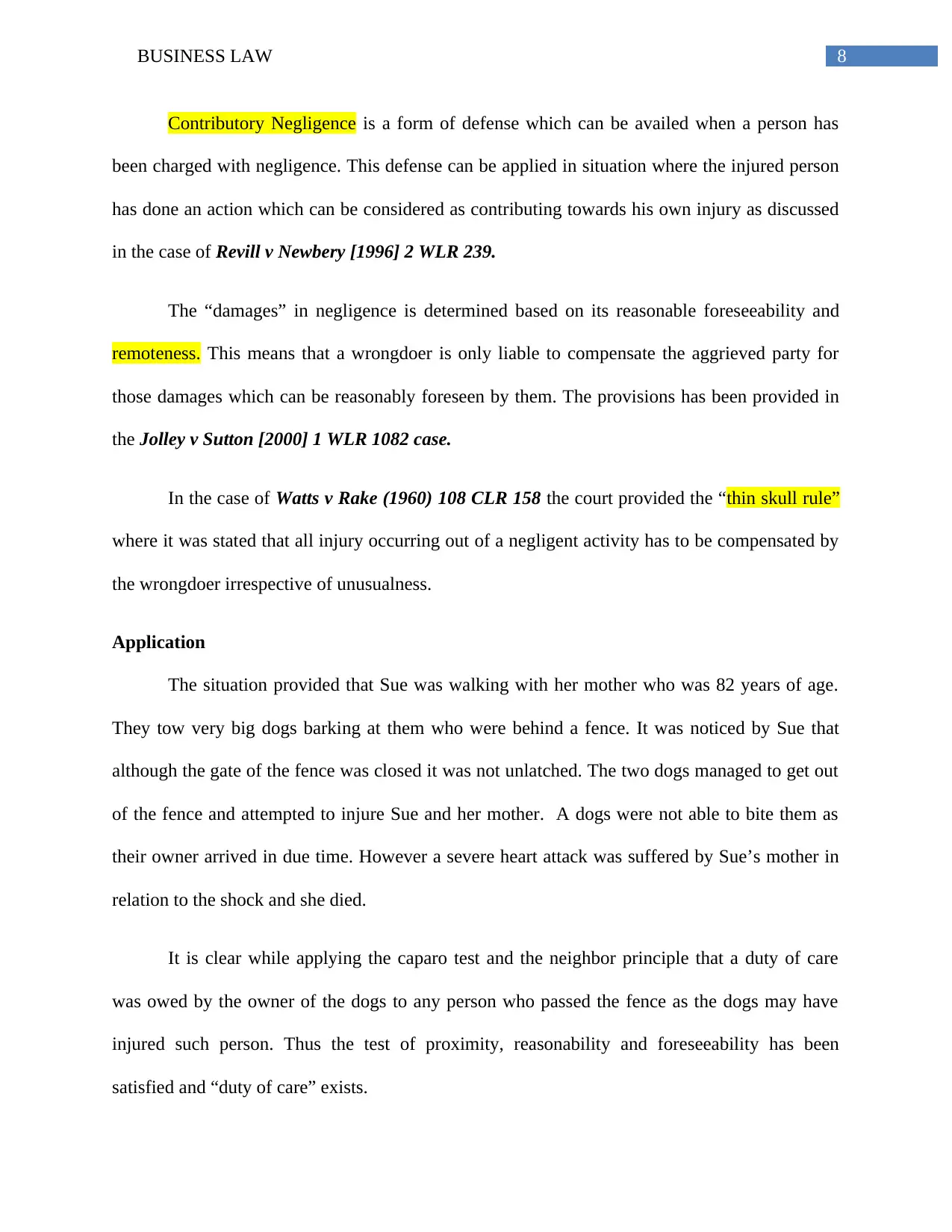
8BUSINESS LAW
Contributory Negligence is a form of defense which can be availed when a person has
been charged with negligence. This defense can be applied in situation where the injured person
has done an action which can be considered as contributing towards his own injury as discussed
in the case of Revill v Newbery [1996] 2 WLR 239.
The “damages” in negligence is determined based on its reasonable foreseeability and
remoteness. This means that a wrongdoer is only liable to compensate the aggrieved party for
those damages which can be reasonably foreseen by them. The provisions has been provided in
the Jolley v Sutton [2000] 1 WLR 1082 case.
In the case of Watts v Rake (1960) 108 CLR 158 the court provided the “thin skull rule”
where it was stated that all injury occurring out of a negligent activity has to be compensated by
the wrongdoer irrespective of unusualness.
Application
The situation provided that Sue was walking with her mother who was 82 years of age.
They tow very big dogs barking at them who were behind a fence. It was noticed by Sue that
although the gate of the fence was closed it was not unlatched. The two dogs managed to get out
of the fence and attempted to injure Sue and her mother. A dogs were not able to bite them as
their owner arrived in due time. However a severe heart attack was suffered by Sue’s mother in
relation to the shock and she died.
It is clear while applying the caparo test and the neighbor principle that a duty of care
was owed by the owner of the dogs to any person who passed the fence as the dogs may have
injured such person. Thus the test of proximity, reasonability and foreseeability has been
satisfied and “duty of care” exists.
Contributory Negligence is a form of defense which can be availed when a person has
been charged with negligence. This defense can be applied in situation where the injured person
has done an action which can be considered as contributing towards his own injury as discussed
in the case of Revill v Newbery [1996] 2 WLR 239.
The “damages” in negligence is determined based on its reasonable foreseeability and
remoteness. This means that a wrongdoer is only liable to compensate the aggrieved party for
those damages which can be reasonably foreseen by them. The provisions has been provided in
the Jolley v Sutton [2000] 1 WLR 1082 case.
In the case of Watts v Rake (1960) 108 CLR 158 the court provided the “thin skull rule”
where it was stated that all injury occurring out of a negligent activity has to be compensated by
the wrongdoer irrespective of unusualness.
Application
The situation provided that Sue was walking with her mother who was 82 years of age.
They tow very big dogs barking at them who were behind a fence. It was noticed by Sue that
although the gate of the fence was closed it was not unlatched. The two dogs managed to get out
of the fence and attempted to injure Sue and her mother. A dogs were not able to bite them as
their owner arrived in due time. However a severe heart attack was suffered by Sue’s mother in
relation to the shock and she died.
It is clear while applying the caparo test and the neighbor principle that a duty of care
was owed by the owner of the dogs to any person who passed the fence as the dogs may have
injured such person. Thus the test of proximity, reasonability and foreseeability has been
satisfied and “duty of care” exists.
⊘ This is a preview!⊘
Do you want full access?
Subscribe today to unlock all pages.

Trusted by 1+ million students worldwide
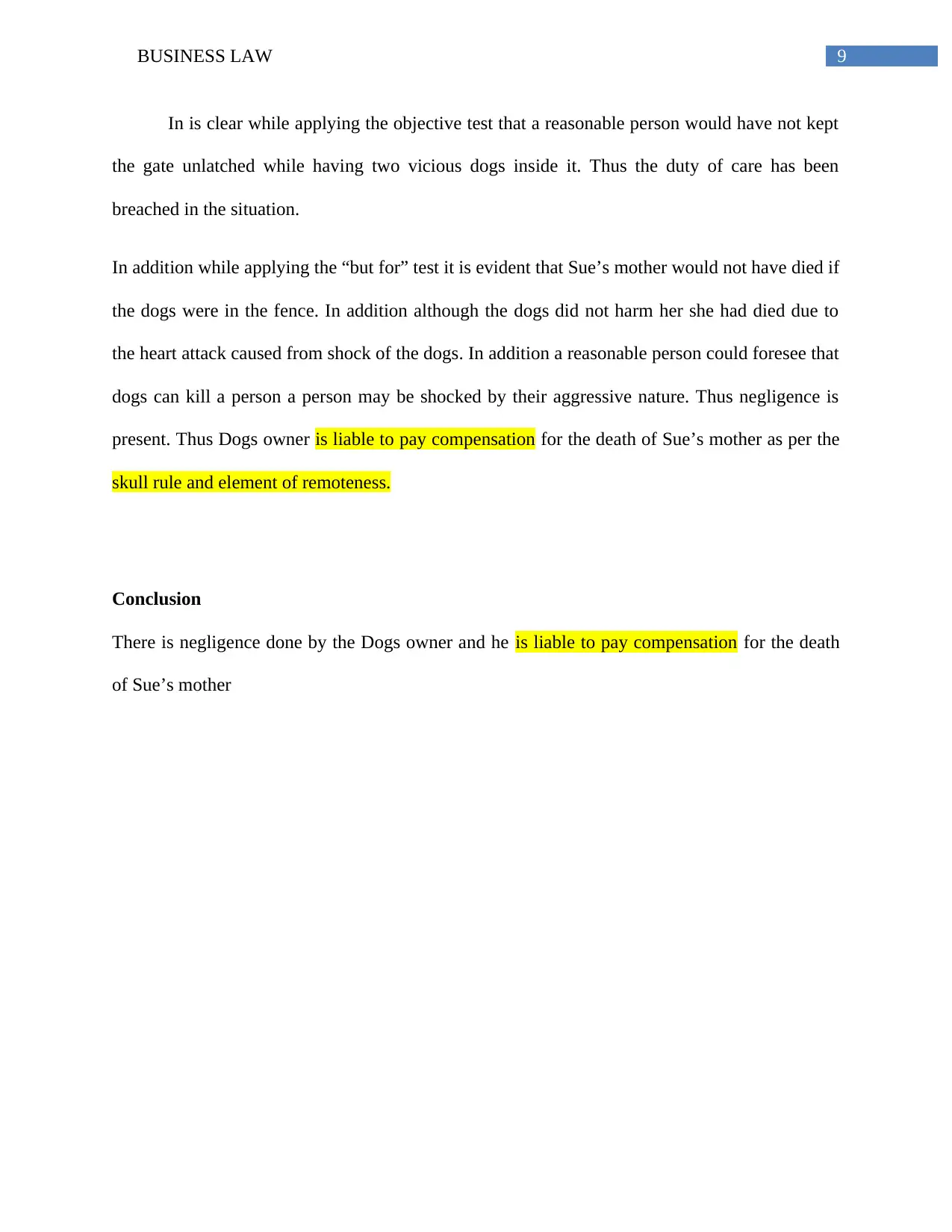
9BUSINESS LAW
In is clear while applying the objective test that a reasonable person would have not kept
the gate unlatched while having two vicious dogs inside it. Thus the duty of care has been
breached in the situation.
In addition while applying the “but for” test it is evident that Sue’s mother would not have died if
the dogs were in the fence. In addition although the dogs did not harm her she had died due to
the heart attack caused from shock of the dogs. In addition a reasonable person could foresee that
dogs can kill a person a person may be shocked by their aggressive nature. Thus negligence is
present. Thus Dogs owner is liable to pay compensation for the death of Sue’s mother as per the
skull rule and element of remoteness.
Conclusion
There is negligence done by the Dogs owner and he is liable to pay compensation for the death
of Sue’s mother
In is clear while applying the objective test that a reasonable person would have not kept
the gate unlatched while having two vicious dogs inside it. Thus the duty of care has been
breached in the situation.
In addition while applying the “but for” test it is evident that Sue’s mother would not have died if
the dogs were in the fence. In addition although the dogs did not harm her she had died due to
the heart attack caused from shock of the dogs. In addition a reasonable person could foresee that
dogs can kill a person a person may be shocked by their aggressive nature. Thus negligence is
present. Thus Dogs owner is liable to pay compensation for the death of Sue’s mother as per the
skull rule and element of remoteness.
Conclusion
There is negligence done by the Dogs owner and he is liable to pay compensation for the death
of Sue’s mother
Paraphrase This Document
Need a fresh take? Get an instant paraphrase of this document with our AI Paraphraser
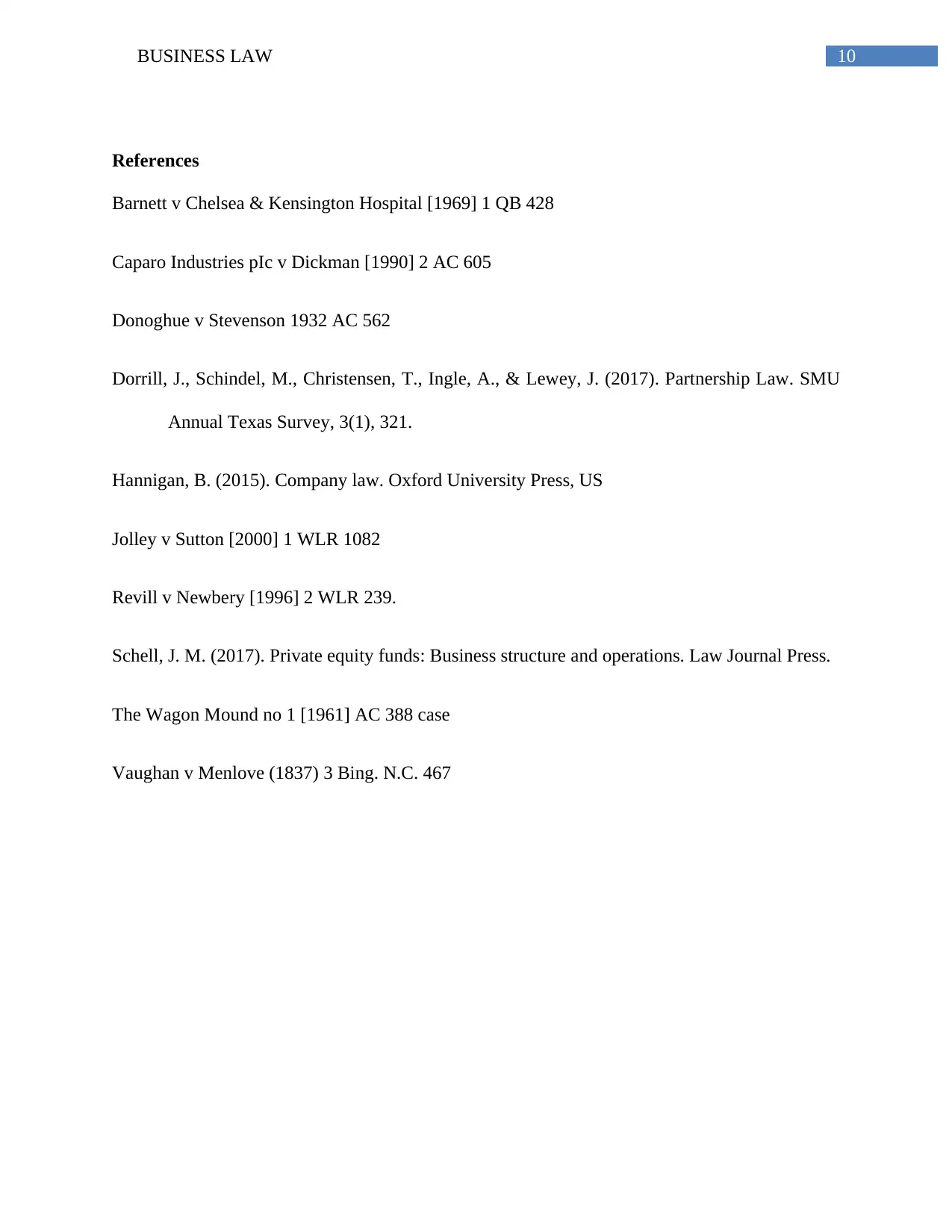
10BUSINESS LAW
References
Barnett v Chelsea & Kensington Hospital [1969] 1 QB 428
Caparo Industries pIc v Dickman [1990] 2 AC 605
Donoghue v Stevenson 1932 AC 562
Dorrill, J., Schindel, M., Christensen, T., Ingle, A., & Lewey, J. (2017). Partnership Law. SMU
Annual Texas Survey, 3(1), 321.
Hannigan, B. (2015). Company law. Oxford University Press, US
Jolley v Sutton [2000] 1 WLR 1082
Revill v Newbery [1996] 2 WLR 239.
Schell, J. M. (2017). Private equity funds: Business structure and operations. Law Journal Press.
The Wagon Mound no 1 [1961] AC 388 case
Vaughan v Menlove (1837) 3 Bing. N.C. 467
References
Barnett v Chelsea & Kensington Hospital [1969] 1 QB 428
Caparo Industries pIc v Dickman [1990] 2 AC 605
Donoghue v Stevenson 1932 AC 562
Dorrill, J., Schindel, M., Christensen, T., Ingle, A., & Lewey, J. (2017). Partnership Law. SMU
Annual Texas Survey, 3(1), 321.
Hannigan, B. (2015). Company law. Oxford University Press, US
Jolley v Sutton [2000] 1 WLR 1082
Revill v Newbery [1996] 2 WLR 239.
Schell, J. M. (2017). Private equity funds: Business structure and operations. Law Journal Press.
The Wagon Mound no 1 [1961] AC 388 case
Vaughan v Menlove (1837) 3 Bing. N.C. 467
1 out of 11
Related Documents
Your All-in-One AI-Powered Toolkit for Academic Success.
+13062052269
info@desklib.com
Available 24*7 on WhatsApp / Email
![[object Object]](/_next/static/media/star-bottom.7253800d.svg)
Unlock your academic potential
Copyright © 2020–2025 A2Z Services. All Rights Reserved. Developed and managed by ZUCOL.




